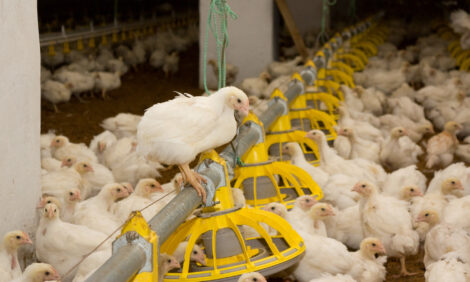



Pressure Put on Poultry Sector to Reduce Campylobacter
UK - A total of 19 of chickens tested in the first nine months of a British Food Standards Agency survey on the prevalence of Campylobacter were positive within the highest band of contamination.In all, 73 per cent of chickens tested positive for the presence of Campylobacter.
And seven per cent of packaging tested positive for the presence of campylobacter.
Only three out of more than 3,000 samples of packaging tested positive at the highest band of contamination - more than 1,000 colony forming units (cfu) per gram.
More than 3,000 samples of fresh whole chilled chickens and packaging have now been tested.
Data continue to show variations between the retailers in the UK, but none is meeting the target for reducing Campylobacter.
The FSA’s 12-month survey, running from February 2014 to February 2015, will test around 4,000 samples of whole chickens bought from UK retail outlets and smaller independent stores and butchers.
The full set of results is expected to be published in May.
UK supermarket chain, Marks and Spencer (M&S), has published a case study showing the results from the retailer’s recently implemented five-point intervention plan to reduce Campylobacter on its chickens.
In the plan, which was drawn up together with leading UK poultry processor 2 Sisters, a series of steps and incentives were introduced to help stop the spread of Campylobacter.
These include:
- A bonus scheme for farmers who produce ‘Campylobacter-free’ farms.
- Zero thinning of flocks to maintain biosecurity of the farm
- Investment in new technology on a dedicated M&S processing line that rapidly chills whole chickens.
- Clearer front of pack labelling on M&S whole chickens, adding a large, front-of pack label that say “Washed and Ready to Cook”.
- The introduction of a ‘double bag’ for M&S chickens, which means they can be placed straight into the oven in a bag, reducing the risk of cross contamination in the kitchen.
The Food Standards Agency (FSA) said that the preliminary results published by M&S indicate a significant reduction in the number of the most highly contaminated birds.
Steve Wearne, FSA Director of Policy, said: “We now know it is possible to make positive inroads in the reduction of Campylobacter.
“Figures released today by M&S show that their intervention plan has resulted in fewer contaminated chickens on sale in their stores. If one retailer can achieve this Campylobacter reduction through systematic interventions then others can, and should.
“Our survey is putting pressure on retailers to work with poultry processors to do more to tackle Campylobacter. We want the industry to reduce the number of the most highly contaminated chickens as we know this will have the greatest impact on public health.
“Campylobacter is killed by thorough cooking but it should not be left to consumers to manage the risk. It is the most common form of food poisoning in the UK, affecting an estimated 280,000 people a year.
“Poultry is the source of the majority of these cases, so the industry should be making every effort to ensure chickens are as free from Campylobacter as possible before they reach customers.”
Richard McDonald, Chair of the ACT (Acting on Campylobacter Together) Board, said: “The UK is leading the way in the search for solutions to reduce Campylobacter levels.
“We have learned a lot over the last five years about which interventions have the potential to make chicken safer. We must continue to work together to apply these successfully and help industry deliver the results we all want to see.
“The ACT Board is central to this work and represents a forum where processors and retailers can come together to discuss their work to tackle Campylobacter and results from the latest interventions.
“This collaborative approach will be essential as the focus shifts to application and delivery.
“Although the impact of industry interventions has not been seen in the results from the FSA survey to date, we look forward to seeing progress in the FSA’s follow-up survey.”
Andrew Large, Chief Executive of the British Poultry Council commented: “We welcome the news that retailers and their suppliers are making significant progress, and hope that proven technology will be made commercially available across the sector.
“The BPC remains committed to collaborative working between industry, retailers and regulators, as we believe this is where long-term consistency will emerge.
“This joint effort is a complement to the creativity and investment we are seeing.
“We are pleased to see the FSA's commitment to solving this problem remains as strong as our own, and we look forward to being able to demonstrate good progress as we move through 2015,” said Mr Large.








